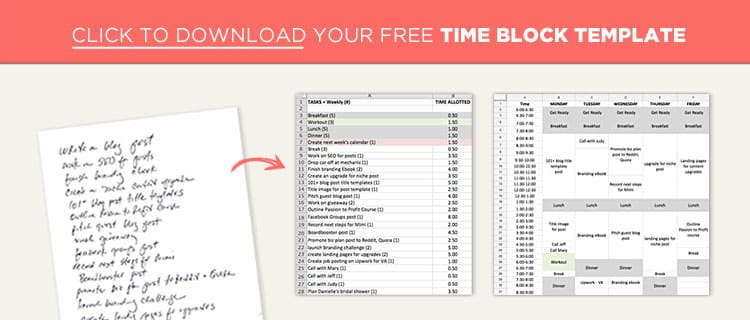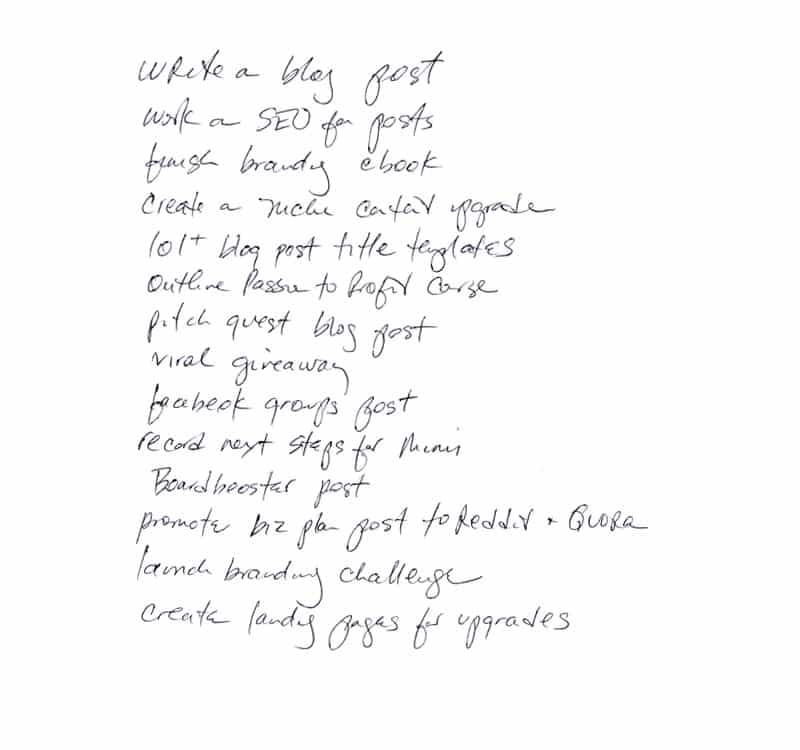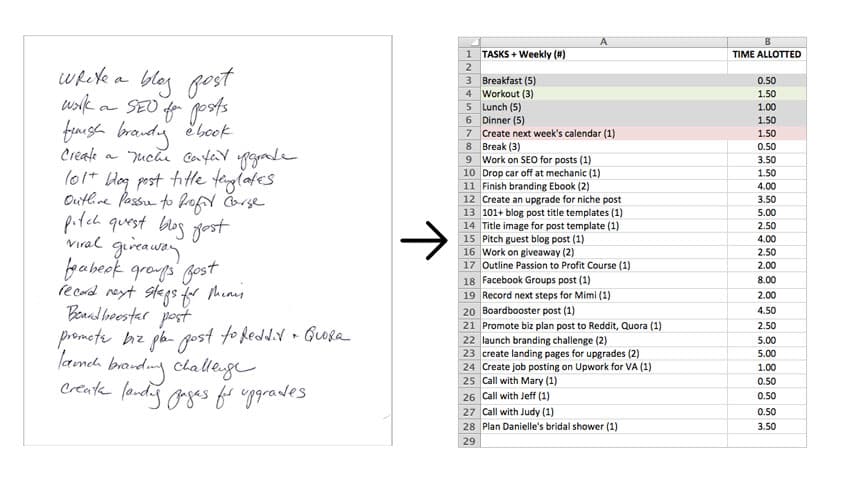
If that sounds confusing, hang in there with me.
I was getting stuff done for sure, just not the right stuff.
I’d start writing a post and get briefly distracted by an email. Then I’d get up, go get a drink, come back, log in to Pinterest, check my feeds, log in to Skype, check my junk mail…
…and back to writing again.
Then a text would come through and I’d get sidetracked. Again.
Sound familiar?
Being an entrepreneur is tricky business. It’s easy to feel flustered and even a bit scattered. There’s so much we have to do, so many reasons to procrastinate, and tons of shiny bright things to take our attention away from the one thing we should be doing.
Oh, and by the way, how do we even know what that one thing is? How can we tell if what we’re working on right now is a must-do or if we’re just spinning our wheels?
I’ve been spending a lot of time on this and think I finally nailed it…
Here’s a short list of things that have helped me stay laser-focused and finally (finally!) get tons of the right stuff done. I hope they help you increase productivity and rock your To-do list too.
With me? Let’s dig in.
1) Get serious about your biz
I know this for sure. It’s super easy to put something down on paper, up on a wall, in Asana, Evernote, or whatever your project management tool is… then let it slide until the next day.
No big deal if you don’t get to it, right? You just start a new list. At least you’re doing something.
Be honest, how many times have you started to write a post but didn’t finish it? Or it was on your list but somehow you didn’t get to it?
Me too…
It feels good to see a whole mess of things you have to do…makes you feel proud and accomplished. Look at how busy I am! Kinda reminds me of the way I hang out in my workout gear all day and think about going for a run. 🙂
At some point along your entrepreneurial journey, though, you’ve got to buckle down and start taking your business (and yourself) more seriously.
I know this is true. It happened to me. Just a few months ago, something shifted and I got serious about my business. I stopped making lists, at least for a while. I stopped checking my junk email 10x a day and spending hours on Pinterest.
The only thing I wanted to do was get things done. And I knew exactly what those things were, even without my list!
When your business really, really matters to you, you know what you have to do. It’s crystal freakin’ clear, friend.
[clickToTweet tweet=”When your business really, really matters to you, that’s when you start getting things done.” quote=”When your business really, really matters to you, that’s when you start getting things done.”]
So my question for you is: What’s stopping you from taking your business seriously? In my case, it was lack of confidence. If this is the same for you, please know that you got this. I’ve got your back. Let’s do it together…
Let’s get super serious. Let’s trust our instincts.
This post is set to publish on Friday. I wanted to put it off because well, it’s been a crazy week and I’m beat. But I’m all serious business over here, what about you? Got a post due tomorrow? Shut down your email, stop surfing, conquer your FOMO, and block off the time to do it. We’ve got work to do! Let’s get it done…
2) Set the right priorities
You know I love my phases of business. We’ve got the early phase, the growth phase, and the blow-up phase.
Knowing what to do starts with looking at which phase you’re in, and then working back from that. This is because your goals will be different for each phase.
Let’s take a look.
In the early stage, your goal is to set a foundation and create a platform for your business. If this is you, your priorities are:
- Brand development
- Website, social profiles
- Blogging
- Building a following
- Growing your email list
In the growth phase, you’re getting traction in your business and making some money. Your goal in this phase is to start shifting your business model from one-to-one, to one-to-many. Your priorities here look like:
- Course creation
- Webinars
- Influencer marketing
- Outsourcing non-core tasks
In the blow up phase, everything’s clicking. You’ve found your sweet spot, your courses are hugely profitable, and your webinars are converting off the charts. Your goal at this phase is to scale your business, so your priorities are:
- On-demand webinars
- Building a team
- Advanced tools + automation
After that, the sky’s the limit! Now that you know your priorities, you can break them down even more and start taking action, which leads me to…
3) Turn your priorities into an action plan
There are a few ways you can do it.
1) Use the Eisenhower method
Named after former President Eisenhower, of course!
If you’re curious, this is just a simple box Eisenhower created to organize his own enormous to-do list. It’s become hugely popular because it works, and maybe it’ll work for you too. I actually prefer another method which I’ll share next, but I do like the way the box shifts my thinking.
Here’s what it looks like:

- Only do what you need to do right now – nothing more or less
- Stop watching TV and wasting time
- Always be thinking about what you can delegate
To be honest though, just about everything in between the Dos and Don’ts is where I get tripped up with this. I’m the kind of girl who has to know exactly what my week looks like. I’m always thinking After today, then what? And what about this HUGE list I have here:
Here’s why I prefer this second way…
2) Use my Time Block Method
If your list looks anything like mine, it kinda sorta makes you want to take a nap. The problem with this list is that everything is a priority. How do you know what to do first?
Enter confusion and procrastination.
Let’s not get caught in that trap, k? Let’s break things down into manageable blocks of time.
The Time Block Method uses a simple Excel template that turns my scratchy list into this:
Related: What to Do When You Don’t Know What to Do Next
See how I’ve included even more things on the spreadsheet? That’s because I’m keepin’ it real, yo. Nothing derails my day faster than things that come up out of the blue.
It’s usually the stuff I know I need to do but pretend I don’t, until of course Wednesday comes and yep, I do have to run to the bank! So now I make it a point to include both personal and business tasks on the spreadsheet.
If you’re curious about the parentheses, all it means is the number of times a task needs to be performed. For instance, let’s say you estimate 4 hours to pitch a guest post, but you don’t want to do it all at once. Instead you want to work in smaller blocks of time. You’d put a (2) next to the task, which means do it twice. In this case, each time block would be 2 hours, for a total of 4.
Want to grab a copy of the template? You can download it here.
We’re almost there, just one more step to go…
On a separate spreadsheet, you transfer your time block onto a visual calendar so you can see your entire week at a glance.
Here’s what that looks like:
In this example, I bit off more than I can chew with my scratchy list. Some things are going to spill over to the next week. But the difference between a scratchy list and my Time Block Template is that things gets very specific. You know exactly what you plan to accomplish and how much time it will take. You also get a feel for your work habits this way and start to plan your time according to the way you like to work. Plus, you can re-prioritize tasks based on your must-do’s and how much time you really have each day.
Tip: I added Asana to my toolkit a few months ago and absolutely love the way I can assign tasks and track everything. What I do is enter the tasks/time-blocks from my calendar and then assign them to either myself or my assistant, with deadlines for each task. Asana even sends me reminders, which helps me increase productivity even more by keeping me focused and on track with projects. I highly recommend checking it out!
If you’d like to use my Time Block Template to be more productive than you already are, you can download it below.






There’s a lot of good info here. A lot to process. I’m a big fan of Excel, and also use MS Project for my construction business. What would you propose for someone who isn’t that adapt at excel? Do you mind if I repost this on my blog? I run a small business blog, and some of this I think will be helpful.
Hi Drew, I’ve haven’t used MS Project so can’t say for sure – the template I used is a Google spreadsheet, which you may find easier. If you repost to your blog, please include a link back to this post!
These strategies along with a the chart boost productivity a ton! Very useful article with a lot of good advice!
Thanks for your comment!
I think Outlook does all of those things – you block time slots, you can colour code (urgent, personal etc). You can assign how long it takes and even enter a location, phone number, who to call, etc. Unless there is something more to that spreadsheet, it looks a bit like inventing a wheel, no? I’m just at this stage of trying to be even more insanely organised than I was before, and trying various things too, but it seems to me that good old Outlook does the job quite well if you make it your habit.
I love using the time blocking template because I can flip back and forth between my calendar and my to-do list. If Outlook works for you, I say stick with it. If it ain’t broke, nothing to fix, right? 🙂
I found your information on Pinterest. Downloaded your free Time Block Template. I am only one day in, but feel this might help me break the log jam of multiple projects and get procrastination on the run. I am looking forward to checking out your other offers of time management information tools. Thank you.
This was quite a Help Sandra, however, the questions here is are you able to do whatever you have written in your template?
Great question, Marjan! That’s something you get better in terms of estimating how long each task will take. At the end of each day, review what you were able to get done and re-prioritize as needed for the next day.
Good tips for structuring your day and getting things done without unnecessary distractions.
I’ve heard about the Eisenhower method but haven’t tried it. The same with time blocking, but I’m going to do it, eventually. The method I’m currently using is called the Kanban method. I’m sure many people heard about it since it’s become quite popular lately, but for those who still don’t know it, here’s some information about it: https://kanbantool.com/kanban-library/introduction . It’s the method worth trying, as far as I know it helps quite a lot of people.
this is great. I’ve seen the Eisenhower method before, but not with your four “D”s. Thanks for this. I’ve signed up for the freebie and your FB group! See you there!
Awesome, Clare. See you there!
Goodness! So much great information here! Your tips are wonderful and worthwhile! I subscribed also! Thank you for sharing your experience and expertise! Blessings!
This is packed full of great advice. I use time blocking too. It took me so long to finally start doing it but now I think it’s the best. thing. ever. To organize my days with! Thanks for sharing all of these tips!
Loved the set the right priorities section. You included actionable tasks that I love and resonate much better with than the basic “write everything down, take it piece by piece” that you see in most other blogs. Thanks for sharing!
It is one of the articles, that need to give it a try to read… I am blogger.. and I work on my own website… when I start writing any blog… i get distract by the phone beep.. background sounds… so it so helpful me…
I found your articles on time blocking and saw the quiz on brand style on the side of the page. I am studying time blocking to find ways to improve my productivity and yet conquere–even if only in small bites–all the other projects I've assigned myself.
However my question to you has more to do with your new Brand HQ product. After taking the quiz and learning my type, I am wondering if something like your product can really help me. I am a self-published author for a niche genre. I write Jane Austen Fan Fiction–primarily different takes on Pride and Prejudice.
Please explain how your product can help me.